I knew about Muroc Dry Lake because my father had been involved with building a bombing target there in the late 1930s. It was still there. Considering the ongoing rivalry at that time with the admirals in the surface navy, it didn’t surprise me that the target turned out to be a large wooden replica of a battleship.
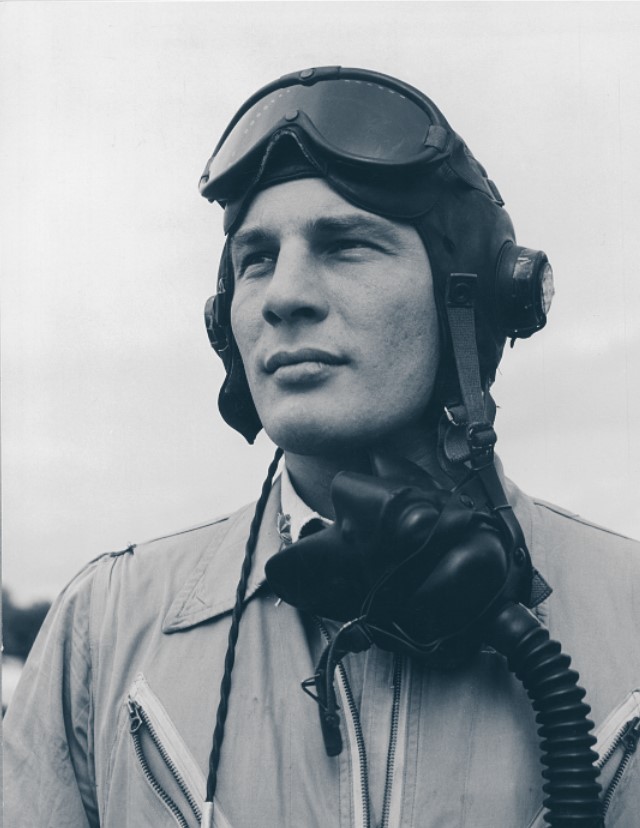
Portrait of a combat leader. When the war ended, Robin Olds was a 22-year-old major commanding the 434th Fighter Squadron.
Flying and ground school. Then more ground school, flying, and still more flying. The P-38 was incredible. Our days were filled with the wonder of the machines, even though the bulk of them were bent and battered, not even worthy of the distinguished status of “war wearies.” There were D models and E models. There were even some earlier C models. Each was unique, with instruments never in the same location, the throttle, mixture, and rpm controls mixed around on the power quadrant, and switches all over the place. Each switch had a placard that hinted at a bewildering variety of functions, mostly mysteries to us, and I suspect also to our instructors, as they seldom mentioned them. The differences, however, could sometimes be quite frightening. On takeoff you’d be looking forward, reach to reduce the power and of course, could shut down the engines if inadvertently pulled back too far. At least the oil and engine coolant shutters were automatic and required only an occasional cursory glance to be sure they were functioning. Accidents were common.
One morning we were outside the quarters playing jungle volleyball when two P-38s pitched out above us for landing. The game paused as usual, all pilots being in the habit of mentally criticizing another pilot’s technique. We never knew who he was, but the second of the two rolled into his bank and kept right on rolling until he smashed into the ground not 500 feet away. After the game, I flew my scheduled flight and then joined some others for a truck ride to the other side of the base for lunch. The road crossed the west end of the runway, where we stopped for two birds taking off. One never got airborne. With smoking brakes he sailed right past our noses and out into the desert. There, the nose gear collapsed, the pilot got out, turned, and waved to us that he was all right. Little did we know that we hadn’t seen anything yet. Coming back from lunch we found two more P-38s nose down, off the same end of the runway. Let’s see, that made four accidents so far. Then on the first flight of the afternoon there were two bailouts. Soon after that, someone tried to land with one engine out and botched it. He went bouncing off the east end of the runway and out onto the dry lakebed. There he stopped with the gear collapsed. Rumor had it he collapsed the gear on purpose, not wanting to face a longer walk back to the squadron. Finding humor in such situations was a macabre sort of pastime. Toward late afternoon two trainees had a midair collision. Neither survived. Flying for the rest of the day was canceled. Who could blame the instruction staff? Nine accidents in one day were going to be hard to explain to the higher-ups.
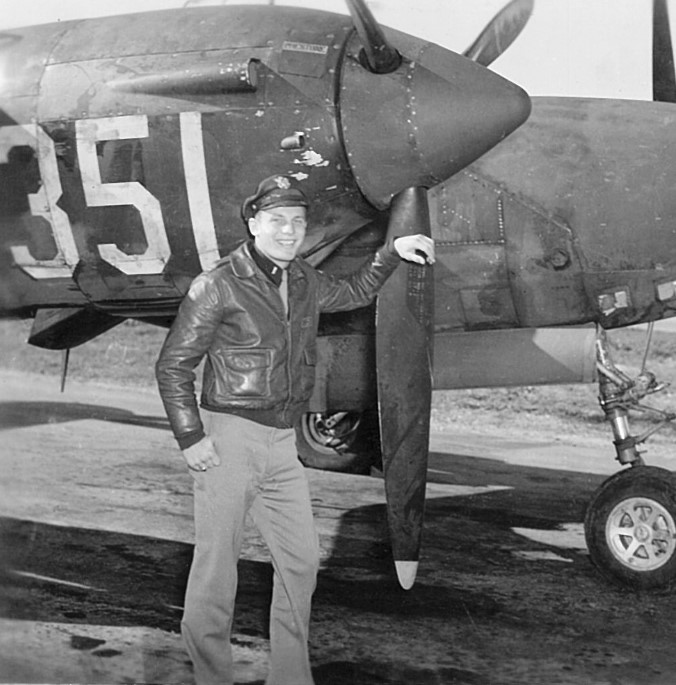
Newly promoted First Lieutenant Olds with his dream machine during operational training in California.
The remaining training days were a mixed bag of frustration and joy: frustration because we couldn’t get an assignment to combat, and joy because there was plenty of flying. Every few weeks we were moved to another base. I guess HQ didn’t know what to do with this small batch of precious West Pointers. Finally, someone told us the Pentagon had ruled we would go overseas only as flight commanders. Fat chance of that! Then we heard that 4th Air Force decided future flight commanders in the units forming up could only be volunteers who had done a prior combat tour. What to do? Keep on flying, of course. Get as much time as we could beg, borrow, or steal. We went from Muroc to Salinas to Monterey Bay. From there we split up. Al Tucker and I were sent to a place called Lomita Flight Strip. The flying was still great. We discovered that the desert north of the San Gabriel Mountains was a wonderful place to buzz, and we got quite good at it. By December we were promoted to first lieutenants. This brought a pay increase, which was gladly accepted, but I worried that our exalted status would only make going to combat more difficult.
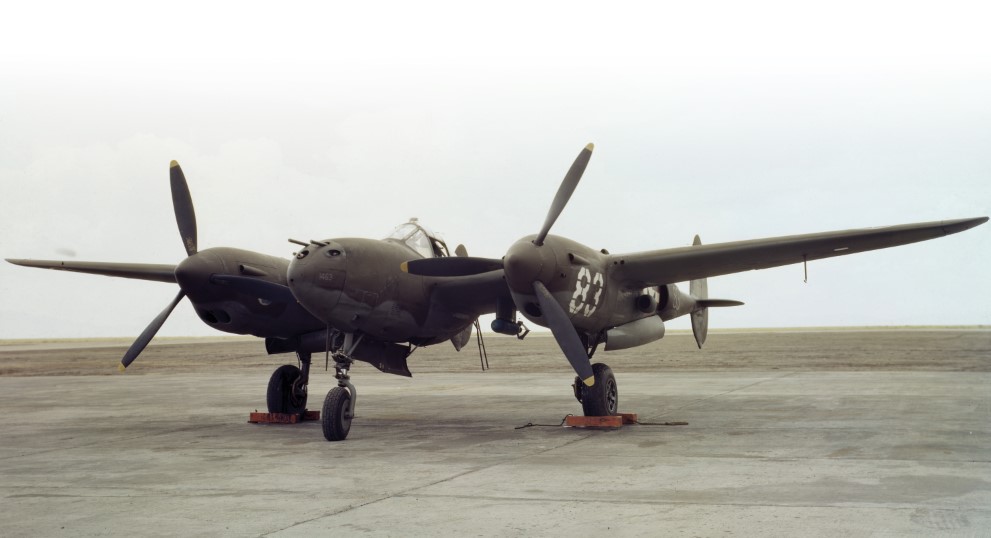
A Training Command P-38F awaits its pilot for a practice bombing mission.
Grounded
All was well until one day at Glendale Al Tucker and I were hauled into ops and yelled at by the flight commander. “Olds, you and Tucker are grounded!” Just like a thunderclap, there it was. Grounded. No more flying. Why, for God’s sake? The flight commander raged on. “Fourth Air Force found out you’ve been leading flights, teaching the replacements, and wasting valuable P-38 time allocated to this squadron. You cannot even fly the BT-13 anymore since those two knotheads ran into Lake Arrowhead yesterday, so none of you guys get to fly that, either. No flying. Nothing.” “But, sir…” “No ‘buts,’” he shouted. “That’s an order!” So there we were, almost eight months out of West Point, past Willie, Matagorda, Muroc, Lomita, Salinas, Grand Central in Glendale, Ontario, and more ditto. Finished with gunnery, through all phases of combat training (several times!), stuck out here among the vineyards of Ontario, and screwed by conflicting rules from two different commands. All we wanted to do was go to war. Was that so bad? Or did the paper pushers think us unfit because we actually agitated to go? The Pentagon had ordained that henceforth and forevermore, no precious little West Pointer would go to war unless he was going to fill a flight commander’s spot in a replacement unit. At this terrible news, Tuck and I looked at each other; anger on our faces and misery in our hearts. We had done our best. We hadn’t asked to stay here.
Tuck was an exceptional pilot, and I wasn’t too bad either. In mock dogfights we had routinely waxed our instructors, all combat veterans. We flew through loose formations, and stuck in there no matter what the instructors tried to do. We understood and executed the combat formation and tactics we were taught (such as they were) better than they did. Those same IPs were the ones who had scheduled us to lead flights that were their responsibility. We did so gladly, while some of them didn’t even come to work for days on end after Tuck and I took over. What now? I could feel my stomach churning. My face felt hot. Tears of rage and frustration were close to the surface. I knew I was in no mood for condition to talk to the boss, but damn it all, what the hell did it matter now? “Let’s just go,” Tuck said. “Where? I asked, as we headed toward his old car. “L.A. fighter wing headquarters,” he replied. Wing HQ was in downtown Los Angeles. Tuck and I marched into the building and looked for someone important. We wound up in the personnel section in front of a sergeant’s desk. The sarge had a friendly face and seemed willing to listen to our tale of woe. “You mean you really want to go to combat?” He seemed surprised. “Yes, sir.” (Well, he WAS a lot older than we were.) “You’re both crazy, but I’m not going to ask you why, just where. So were in hell do you lieutenants want to go?” “England!” we chorused. I don’t know about Tuck, but I could have kissed the man. Hope sprang like a flame. The sergeant went to a wall chart, stood a moment, and then came back. “OK, there’s a group forming up right now. Three squadrons: Lomita, Palmdale, and Santa Rosa. They aren’t fully manned or trained yet, but they’re going. I’m not allowed to say where, but you won’t be disappointed. Any more of you in the same boat?” “Yes, sir, there are.” We named five other classmates going through the same mess, and the good sarge started typing. Tuck and I tried to look nonchalant as our savior worked away on his machine. I guess we were both worried some major or colonel would walk by and ask us what the hell we were doing, but the sergeant seemed totally unconcerned. The 15 minutes it took him to finish typing seemed like an eternity, but when he finished he went over to a mimeograph machine and soon handed over a stack of orders covering all seven of us. It hadn’t occurred to us to ask the others whether they wanted to be included! Which proves that if you want to cut red tape and get something done in this man’s army, go to the NCOs!
Off to war
Olds and his conspirators were assigned to the 479th Fighter Group, which arrived in Britain in April-May 1944, based at Wattisham, Suffolk. “Riddle’s Raiders” arrived just in time for D-Day.
The base had beautiful quarters, good mess, adequate hangars, and brand-new airplanes. In fact, it was the best damned place I’d been stationed in the Army. Even the English rain was refreshing. I flew one of our new ships, a J15-LO, in the first week. God, they were sweet! It’s unbelievable what an improvement they were over the older aircraft. Buzzing was almost expected here, so everyone did it. My own airplane arrived May 25, a spanking new P-38J, just under 20 hours flying time on her. It was a thrill to drink in the beauty of that living piece of machinery and realize it would be mine. It was my future, my survival or demise in this war. Sergeant Glen Wold, my crew chief, was enthusiastic. We had already plotted the myriad little tweaks and adjustments we would to make 28707 the best flying plane on the field. I thought we’d name it for Scat Davis, my roommate at the Point. Even though he’d been disappointed when he couldn’t fly because of his eyesight, Scat would at least be there symbolically. Wold took care of it that night, painting Scat II on the nose for my first mission the next day. My first combat was anticlimactic. I saw a few half-hearted puffs of flak but sure loved the hot-metal smell of my new P-38, the odors of oil, hydraulic fluid, ozone from the radio tubes, leather from the seat, and the faint whiff of residual perfume from the WASP who had delivered it. The only thing missing was some burned powder from the guns. On the second mission of the day we went on a patrol over France and I damned near passed out from lack of oxygen. In debrief the major crawled all over me for not flying perfect formation. I doubt he could have flown perfect formation either, without oxygen at 20,000 feet. It was one of those simple little mistakes that could get somebody killed, and I had gotten away with, at least this time.
Front row for D-Day
Those of us who had pleaded and fought to go on the first missions of D-Day had frontrow seats in the crowded briefing room that morning. Our mission was to fly top cover for the landing forces, to protect the ships from Luftwaffe attack. The weather and intelligence were the same as the day before: stinko and guesswork. We took off at dawn in miserable weather, then hurried to our rendezvous off the coast of Normandy. There, the vast panoply of war was spread before us in a mind-numbing vista. Gunfire from cruisers and destroyers flashed in the gloom as they shelled the tops of the bluffs along the beaches. Strange, bargelike craft spewed barrages of flaming rockets toward unseen targets ashore. Small craft crowded with men circled near their mother ship and then, as we arrived, set course for the beaches. Columns of black smoke marked burning ships already hit by the German shore batteries. The sea around the small boats boiled and frothed with fountains of gunfire. Occasionally, a boat erupted in flame and smoke, to disappear quickly in the roiling water. My stomach churned, knowing that brave young men were dying even before reaching land. We orbited, watching from just offshore. Our orders were to keep over the boats to protect them, but this was too much, too intense, too huge, and too personal to want to obey that order. Over and over, we had been admonished not to fire at anything on the ground. The planners had forecast the situation to be confusing, and above all, we didn’t have any air-ground communications to make sure we knew friend from foe. But, goddamn it, we could easily see the gray-uniformed German troops firing down on our GIs from the top of the cliffs. Those clifftops were tempting! I knew we could make passes without endangering our troops. I dutifully obeyed my orders. Along the beaches we flew, back and forth, over and over; as far as I could tell, the only people shooting at us the whole time were our own naval guys. Under the circumstances, it was hard to blame them, though later we wondered about the extent of their recognition training. I couldn’t imagine anything in the air that looked friendlier than a P-38 with black-and-white striped painted all over it The Luftwaffe never showed up. Our flailing back and forth counted for nothing except perhaps adding a bit of noise to the din. We were part of the chorus without a speaking part. Finally, it was time for use to be relieved. We headed back to England, awed by the immensity of what we had witnessed and fully aware of the absolute necessity to keep those troops of ours safely on the beachhead.
Victories
Once freed of the Normandy patrol responsibility, the 479th Group returned to its usual duties. On August 14 the P-38s were briefed to destroy a bridge in northern France. Olds, supremely confident of his navigation, was convinced that the mission leader was lost so Olds went his own way—and bombed the bridge. Then …
Two dark shapes suddenly flew across the road left to right about a mile ahead of me. They were just a little higher than I was. I turned right to cut them off, got down on the rammed the props into high, and shoved the throttles to the wall. My P-38 leaped ahead as though kicked by a mule. The cutoff angle was good and I could see I would be coming in behind the bogeys. I still didn’t have a positive ID, but every instinct told me they had to be German. Instinct is no good when you’re coming up behind a target with a 20mm and four .50 caliber guns ready to shoot. It is particularly no good when your adrenaline is pumping. Patience … patience. I wanted these shadowy shapes to be Focke Wulf 190s. My instincts told me they were Jerries, not a couple of Jugs out of 9th Air Force. Please, bogeys, please turn just a little. Give me an aspect where I can get a positive ID. I’m closing fast. There isn’t much time left. I pressed rudder and slid the pipper onto the trailing aircraft’s left wing. Another second and suddenly, I could see the Iron Cross on the side of the leader’s fuselage. No time left now. I squeezed the trigger. The wingman’s bird lit up with strikes, spewed heavy smoke, rolled inverted, and hit the ground with a huge explosion. I had to get the other 190 before he gained an advantage on me. He made a violent left break the moment his wingman was hit. I followed, staying inside his turn, knowing my left wingtip was no more than 20 feet off the ground. The G-forces came on hard but I was scarcely aware of them. I flew the pipper slowly through his fuselage pulling ahead, trying to get about a 100- mil lead. I pressed the trigger in a short burst and watched as strikes moved down his fuselage. Perfect! Another burst, more strikes, and he suddenly pulled straight up. The canopy separated and the pilot came out as though he had a spring in his seat. His chute opened immediately and he swung under it. I had pulled up with him and rolled inverted in time to see his aircraft hit in the middle of a field. I rolled into a hard left bank and watched through the top of my canopy as the Jerry landed close to his burning aircraft. He started running as I came around to point my nose at him. I dove at him and he flopped onto his belly. He thought I was going to strafe him. No such thing! I buzzed him there in the mud and pulled up to do two victory rolls. I hoped he saw them. Then I felt like an ass doing such a silly, damned-fool, kid thing like that. Obviously I’d read too much of G-8 and his Battle Aces and watched too much of “Wings” and “The Dawn Patrol”! Olds added to his score with a triple victory later in August before the 479th converted to Mustangs. Thus he probably became the only pilot to make ace in both the P-38 and P-51.
Recalling the transition, Robin said, “There were some mixed emotions. All of us had been weaned on the P-38. We loved it like a first love, maybe more. Hemingway had written about it. A pilot loves his first fighter and it is never replaced in his affection. As for me, as much as I loved the P-38, I couldn’t wait to get into the Mustang. No more compressibility, better range, and some pilots claimed better maneuverability. We hoped so. In any event, it was coming and I was excited.
BY ROBIN OLDS VIA CHRISTINA OLDS
Excerpted from Fighter Pilot by Christina Olds and Ed Rasimus, St. Martin’s Press, 2010.
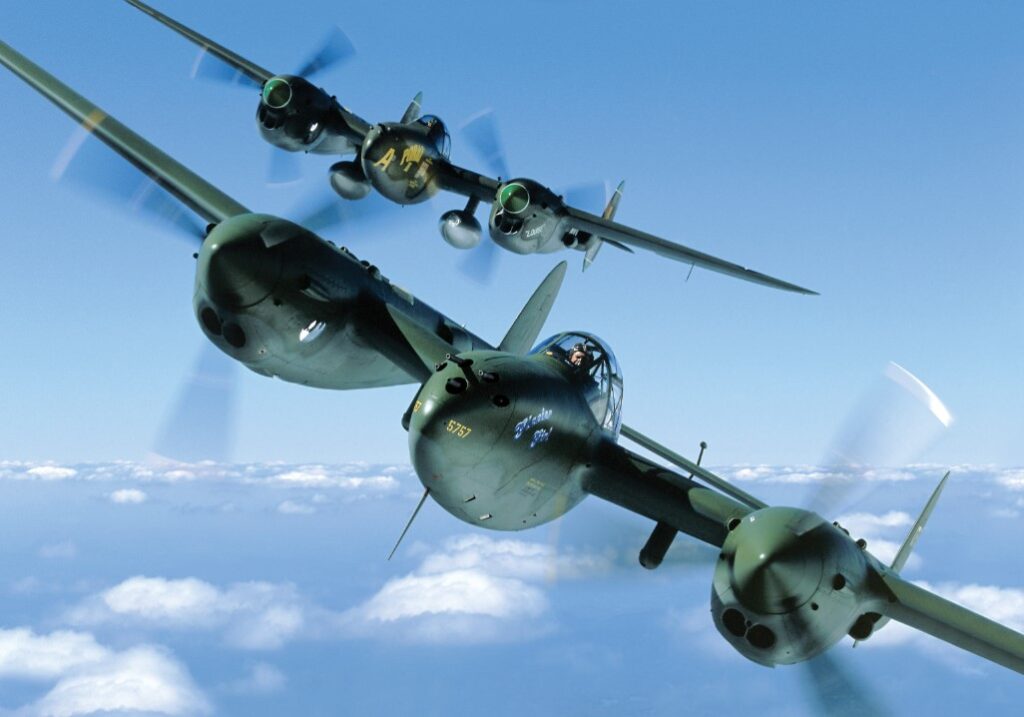
Robin Olds was born to be a fighter pilot and his career began in the P-38, where he made good use of the firepower concentrated in the nose. (Photo by John Dibbs/facebook.
com/theplanepicture)



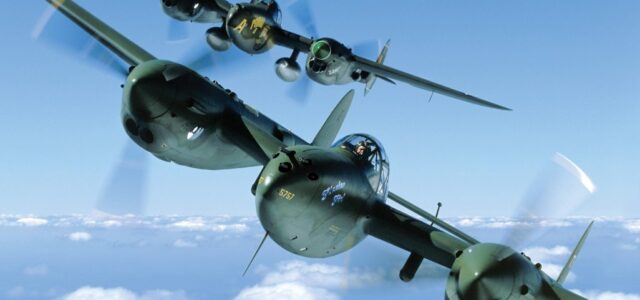













Great story from a true hero of our time.Gladd he was on our side.
CHRISTINA – YOUR DAD WOULD BE PROUD OF YOU – YOU KEEP HIS LEGEND ALIVE – HE WAS A GREAT MAN AND I RESPECTED HIM –
great p38 story
I was very fortunate to meet Col Olds at the national biplane convention in Bartlesville Oklahoma some years ago. I was very impressed with his modesty and the humble manner with which he addressed the crowd. As a former naval aviator and F-4 pilot I wished I could have talked with him at the bar later, alas he was as you could imagine, much sought after that night. I could only introduce myself and convey my highest regards.
Christina,
Great article. I have a picture of you father standing in front of a B26
(“Liberty Run”). The photo was taken by my father, who was also assigned to the 479th FG. I would be happy to forward it to you.
Respectfully.